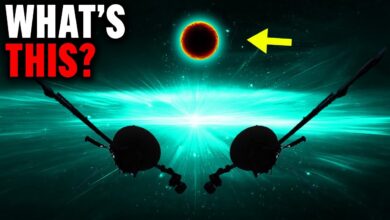Planet 9 Exists! New Evidence Confirms Its Presence Beyond Neptune
Scientists Unveil Compelling Evidence for Mysterious Planet Nine — A Hidden Giant Shaping Our Solar System’s Edge
For decades, astronomers have theorized about a colossal, unseen world lurking in the farthest reaches beyond Neptune. This enigmatic “Planet Nine” has long been a cosmic ghost — impossible to detect directly but hinted at by the gravitational dance of distant objects. Now, thanks to a convergence of groundbreaking observations, sophisticated computer simulations, and unexpected spacecraft data, the strongest evidence yet points to its existence: a massive ice giant roughly five times the size of Earth quietly orchestrating the architecture of our solar system’s frontier.
The Curious Case of Clustering Orbits
The journey to uncover Planet Nine’s secrets began in 2016, when Caltech astronomers Konstantin Batygin and Mike Brown noticed something extraordinary. Several distant trans-Neptunian objects (TNOs) — icy remnants orbiting far beyond Neptune in the Kuiper Belt — shared bizarrely similar, elongated orbits. These objects all swing close to Neptune before soaring outwards to the fringes of the solar system, their orbital planes tilted about 30 degrees compared to the main planetary disk.
Statistically, the odds of this alignment occurring by chance are staggeringly low — less than 0.00002%. As astronomers discovered more TNOs, the clustering pattern became undeniable: 13 such bodies all pointing their closest approaches to the Sun in nearly identical directions. This phenomenon strongly suggests the gravitational influence of a massive, hidden shepherd planet herding these distant objects like a cosmic sheepdog.
Simulating a Hidden Giant
To test the theory, scientists developed intricate computer simulations, recreating billions of years of solar system evolution in mere weeks. Without Planet Nine, the orbits of these TNOs appear random and scattered. However, when a planet about five Earth masses is introduced into the model at roughly 500 astronomical units (AU) from the Sun, the simulations perfectly reproduce the observed clustering, orbit shapes, and tilts.
One astronomer remarked, “The puzzle solved itself.” The presence of Planet Nine elegantly explains not only the mysterious orbital grouping but also predicts where other similar objects may be found — a prediction increasingly validated as new discoveries are made.
Spacecraft Reveal the Invisible Tug
Adding to the mystery, data from the Pioneer and Voyager spacecraft, humanity’s farthest explorers, reveal tiny but persistent gravitational anomalies that defy explanation by known solar system bodies. These subtle tugs align closely with Planet Nine’s predicted position, despite the probes traveling in different directions across the outer solar system.
Even the New Horizons spacecraft, which famously flew past Pluto in 2015, is being monitored for similar gravitational hints that could help pinpoint Planet Nine’s elusive location.
Sedna and the Extreme Trans-Neptunian Objects
The dwarf planet Sedna — discovered in 2003 — has puzzled astronomers with its unusually elongated orbit, never venturing close to Neptune and defying traditional models of the solar system. Planet Nine’s immense gravity offers a neat explanation for Sedna’s orbit, as well as for other extreme objects like 2012 VP113 (“Biden”) and 2015 TG387 (“Goblin”).
Without a massive planet anchoring their paths, these orbits would be unstable over millions of years, scattering the objects unpredictably.
Untangling the Sun’s Tilt Mystery
Planet Nine may also be the missing piece explaining the Sun’s curious 6-degree tilt relative to the orbital plane of the main planets. Simulations show that the giant planet’s gravitational pull could have slowly twisted the Sun’s axis over billions of years, perfectly matching the observed misalignment — a feat no other theory has accomplished.
Origins: Born Here or Captured?
Astronomers debate how Planet Nine ended up on its distant, tilted orbit. Two leading scenarios emerge:
-
Ejected from the Inner Solar System: It might have formed near Uranus and Neptune and been gravitationally catapulted outward during the chaotic early years of the solar system, possibly by Jupiter or Saturn’s influence.
-
Captured from Another Star: Alternatively, Planet Nine may be a rogue exoplanet captured during a close encounter with another star when the Sun was still forming in its stellar nursery — a scenario supported by star cluster dynamics and the planet’s unusual orbit.
Confirming either origin hinges on directly observing the planet itself and studying its composition.
The Hunt Intensifies
Current models place Planet Nine at an average distance of about 500 AU — 500 times the Earth-Sun distance — with an elongated orbit stretching from roughly 200 AU to nearly 1,100 AU. This extreme distance makes it faint and slow-moving, challenging detection efforts.
Innovative techniques like “shift and stack,” which combine hundreds of long-exposure images to reveal faint moving objects, are key to spotting this dim wanderer. The soon-to-be-operational Vera C. Rubin Observatory in Chile, equipped with a massive 3.2-gigapixel camera, promises a breakthrough in surveying the outer solar system.
Meanwhile, the James Webb Space Telescope is scanning the skies in infrared, seeking faint heat emissions from the planet’s frigid surface, which may plunge to –226°C.
A World of Ice and Mystery
Planet Nine is likely an ice giant akin to Neptune, with a dense rocky core wrapped in layers of water, ammonia, and methane ice, and cloaked by a hydrogen-helium atmosphere. Its extreme cold freezes methane into snow, potentially giving the planet a pale blue or white appearance.
It might also host moons or rings, like the gas giants we know, bearing clues about its tumultuous past.
A Discovery That Could Rewrite Astronomy
Finding Planet Nine would revolutionize our understanding of solar system formation and structure, and shed light on the prevalence of similar distant planets around other stars in the Milky Way. It could turn out to be a common, yet previously invisible, type of planet in the galaxy.
With powerful telescopes and advanced simulations working in tandem, the scientific community is optimistic. Within the next few years, we may finally unveil this mysterious “neighbor,” rewriting textbooks and expanding humanity’s cosmic perspective.
The search for Planet Nine is no longer just a theory — it’s the front line of astronomical discovery, promising a historic breakthrough that will reshape how we see our place in the universe.




